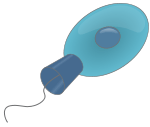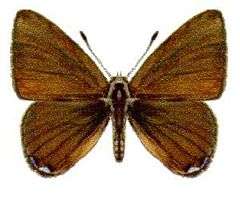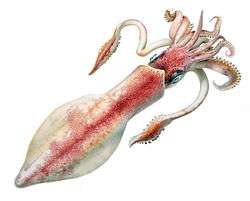ParaHoxozoa
| ParaHoxozoa | |
|---|---|
| Scientific classification | |
| Kingdom: | Animalia |
| Subkingdom: | Eumetazoa |
| Clade: | ParaHoxozoa Ryan et al., 2010 |
| Clades | |
The ParaHoxozoa are a proposed basal Diploblast/Eumetazoa clade as sister of the Ctenophora. It consists of the Bilateria as well as the Placozoa and Cnidaria. [1][2][3][4][5][6][7]
Characteristics
The Parahoxozoa group was defined based on the presence of several gene (sub)classes (HNF, CUT, PROS, ZF, CERS, K50, S50-PRD), as well as Hox/ParaHox-ANTP from which the name of this clade originated. It was later found that a gene of the same class (ANTP) as the Hox/ParaHox, the NK gene and the Cdx Parahox gene, is also present in Porifera.[8][9] Nevertheless, the Parahoxozoa as originally defined without Porifera may be a monophyletic clade, and is continued to be used as such.[10]
| Apoikozoa (950) |
| ||||||||||||||||||||||||||||||||||||||||||||||||
References
- ↑ Feuda, Roberto; Dohrmann, Martin; Pett, Walker; Philippe, Hervé; Rota-Stabelli, Omar; Lartillot, Nicolas; Wörheide, Gert; Pisani, Davide. "Improved Modeling of Compositional Heterogeneity Supports Sponges as Sister to All Other Animals". Current Biology. doi:10.1016/j.cub.2017.11.008.
- ↑ Pisani, Davide; Pett, Walker; Dohrmann, Martin; Feuda, Roberto; Rota-Stabelli, Omar; Philippe, Hervé; Lartillot, Nicolas; Wörheide, Gert (15 December 2015). "Genomic data do not support comb jellies as the sister group to all other animals". Proceedings of the National Academy of Sciences. 112 (50): 15402–15407. Bibcode:2015PNAS..11215402P. doi:10.1073/pnas.1518127112. ISSN 0027-8424. PMC 4687580. PMID 26621703.
- ↑ Simion, Paul; Philippe, Hervé; Baurain, Denis; Jager, Muriel; Richter, Daniel J.; Franco, Arnaud Di; Roure, Béatrice; Satoh, Nori; Quéinnec, Éric (3 April 2017). "A Large and Consistent Phylogenomic Dataset Supports Sponges as the Sister Group to All Other Animals". Current Biology. 27 (7): 958–967. doi:10.1016/j.cub.2017.02.031. ISSN 0960-9822.
- ↑ Giribet, Gonzalo (1 October 2016). "Genomics and the animal tree of life: conflicts and future prospects". Zoologica Scripta. 45: 14–21. doi:10.1111/zsc.12215. ISSN 1463-6409.
- ↑ Laumer, Christopher E.; Gruber-Vodicka, Harald; Hadfield, Michael G.; Pearse, Vicki B.; Riesgo, Ana; Marioni, John C.; Giribet, Gonzalo (2017-10-11). "Placozoans are eumetazoans related to Cnidaria". bioRxiv: 200972. doi:10.1101/200972.
- ↑ Ryan, Joseph F.; Pang, Kevin; Mullikin, James C.; Martindale, Mark Q.; Baxevanis, Andreas D. (2010-10-04). "The homeodomain complement of the ctenophore Mnemiopsis leidyi suggests that Ctenophora and Porifera diverged prior to the ParaHoxozoa". EvoDevo. 1: 9. doi:10.1186/2041-9139-1-9. ISSN 2041-9139.
- ↑ Eitel, Michael; Francis, Warren; Osigus, Hans-Jürgen; Krebs, Stefan; Vargas, Sergio; Blum, Helmut; Williams, Gray Argust; Schierwater, Bernd; Wörheide, Gert (2017-10-13). "A taxogenomics approach uncovers a new genus in the phylum Placozoa". bioRxiv: 202119. doi:10.1101/202119.
- ↑ Fortunato, Sofia A. V.; Adamski, Marcin; Ramos, Olivia Mendivil; Leininger, Sven; Liu, Jing; Ferrier, David E. K.; Adamska, Maja (2014-10-30). "Calcisponges have a ParaHox gene and dynamic expression of dispersed NK homeobox genes". Nature. 514 (7524): 620–623. doi:10.1038/nature13881. ISSN 0028-0836.
- ↑ Larroux, Claire; Fahey, Bryony; Degnan, Sandie M.; Adamski, Marcin; Rokhsar, Daniel S.; Degnan, Bernard M. "The NK Homeobox Gene Cluster Predates the Origin of Hox Genes". Current Biology. 17 (8): 706–710. doi:10.1016/j.cub.2007.03.008.
- ↑ Giribet, Gonzalo (2016-10-01). "Genomics and the animal tree of life: conflicts and future prospects". Zoologica Scripta. 45: 14–21. doi:10.1111/zsc.12215. ISSN 1463-6409.
This article is issued from
Wikipedia.
The text is licensed under Creative Commons - Attribution - Sharealike.
Additional terms may apply for the media files.



